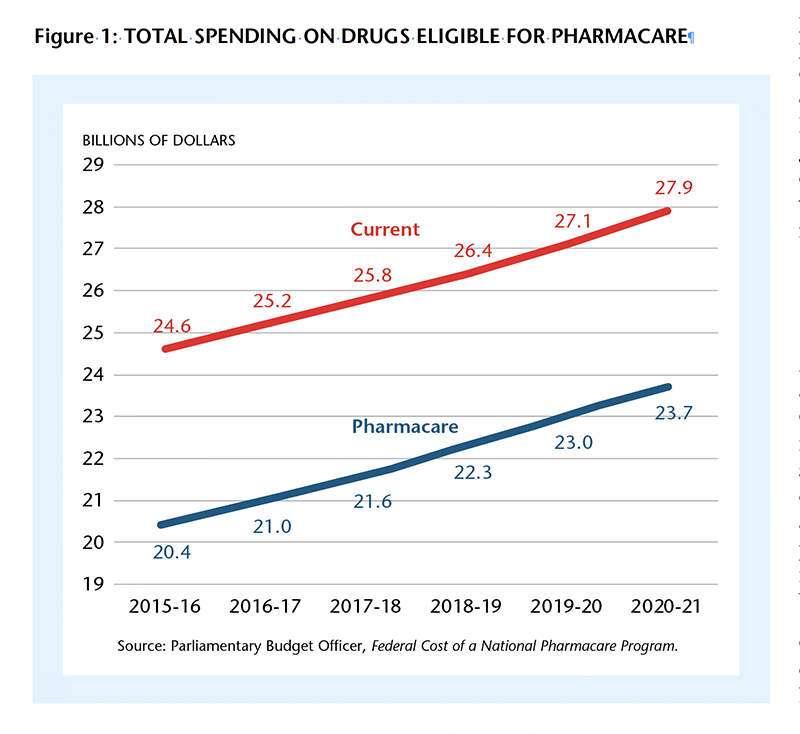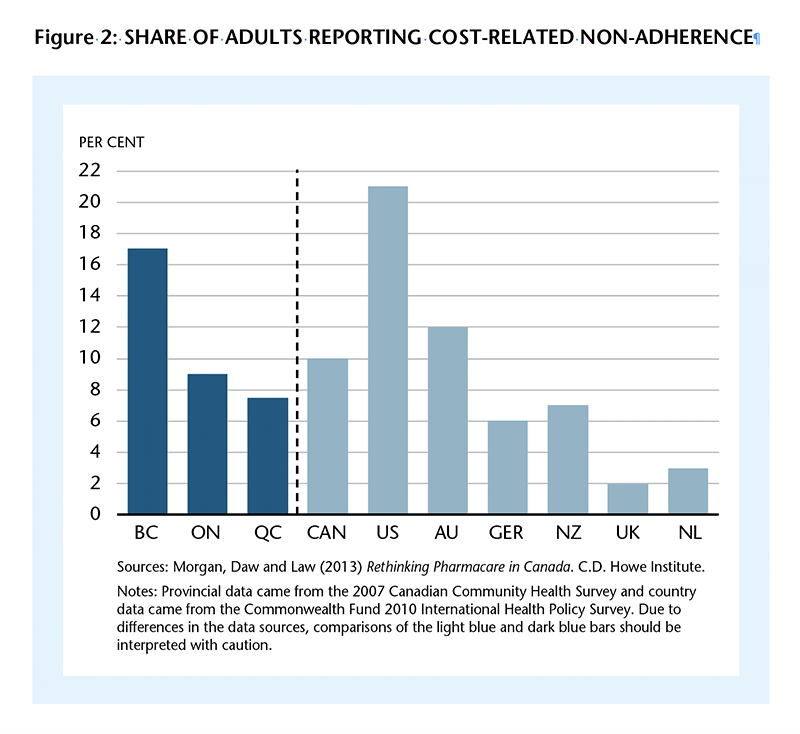Call it Whatever You Want, but the Time has Come for National Pharmacare in Canada
Alannah McBride and Randall Bartlett
Canada is the only G7 country that provides universal health care but not universal drug coverage. In its 2018 budget, the Trudeau government unveiled an Advisory Council on the Implementation of National Pharmacare to report in spring, 2019. As Alannah McBride and Randall Bartlett write, there is already no shortage of material from which to glean estimates on the costs and permutations of a national drug coverage scheme.
Is Canada going to adopt a national pharmacare program? While you wouldn’t be blamed for having been left with that impression after perusing Budget 2018, Finance Minister Bill Morneau was quick to re-label any potential pharmacare plan as, in fact, a strategy. If nothing else, this certainly points to the fact that semantics remain alive and well in Ottawa. To advise on that strategy, the Advisory Council on the Implementation of National Pharmacare, led by Ontario’s former health minister Eric Hoskins, has been struck to explore what filling these coverage gaps might look like.
What does the current landscape for prescription drug coverage in Canada look like and what does this mean for the relevance of any national pharmacare strategy? According to the Canadian Life and Health Insurance Association, as of 2015, an estimated 70.5 per cent of Canadians are privately covered through employer-provided plans, which spent the lion’s share of their coverage on pharmaceuticals.
So, what about the rest of Canadians? Much as Morneau described it, there’s a patchwork of programs across Canada that cover certain groups and not others. This type of system evolved because the Canada Health Act only included drug coverage under hospital services. However, provinces and territories have taken it upon themselves to create a range of coverage plans to fill the gaps in the private drug insurance landscape. And it is into this hodge podge of different systems that the federal government has inserted the newly-minted Advisory Council.
As an example, in Ontario there’s the Ontario Drug Benefit (ODB). The ODB automatically covers anyone 65 and over, and extends to a few other groups of people including: those living in long-term care facilities and enrolled in home care; people enrolled in Ontario Works and Ontario Disability Support Program; and people who pay more than 3 per cent of their after-tax incomes towards prescriptions. This benefit was recently expanded to encompass Ontarians under the age of 25, known as OHIP+.
Notably, the ODB doesn’t always pay 100 per cent of drug costs, as there are sometimes small deductibles (amount the individual has to pay out-of-pocket over a year before coverage begins) and co-payments (amount the individual has to pay per prescription) depending on the group and income level that the individual falls under. For people aged 65 and older, the ODB has two different potential cost-sharing mechanisms: co-payments and deductibles.
There is no deductible for lower income seniors and for higher income single seniors the deductible is $100. For the higher income seniors, the co-payment is no more than $6.11 per prescription and no more than $2 for any other demographic covered under the ODB. This may seem reasonable enough. However, some studies have shown that any co-payment or deductible at all affects whether or not someone actually fills their prescription. In contrast, there are no co-payments or deductibles for OHIP+. This new program covers more than 4,400 drugs (the Ontario formulary) and is billed before private insurers are. These kinds of details change how the system is used and may therefore impact the health outcomes of Canadians.
Other provinces have various types of pharmaceutical coverage as well. British Columbia, for instance, has what they call PharmaCare, which provides coverage to families and individuals based on their incomes. It also covers various other groups, such as recipients of B.C Income Assistance, residents of licensed residential care facilities and people living with cystic fibrosis, among others.
These systems obviously let some Canadians fall through the cracks. According to a 2017 report by the Parliamentary Budget Officer (PBO), who estimated the cost of a national pharmacare program, 17 per cent of all drug expenditures are paid out-of-pocket by individuals. Notably, residents of B.C. and Manitoba pay a larger proportion of out-of-pocket spending compared to other provinces, at about 25 per cent. From the same report, an estimated 2 per cent of Canadians don’t have any drug insurance at all and another 10 per cent of Canadians have drug coverage but still lack the financial ability to pay for their prescriptions.
Having a health care system, as we do in Canada, that is meant to facilitate access to health services without financial barriers but is lacking an inclusive drug coverage program seems problematic. There are many academic papers which estimate the health effects of having drug coverage versus no coverage. Many find that socioeconomic status played a large role in predicting death and severe medical conditions, particularly for individuals under the age of 65 years. Beyond age 65, the outcome gap closed somewhat, possibly as a result of more ready access to public drug coverage and income support across Canada.

According to the Organisation for Economic Cooperation and Development (OECD), Canada pays 17.5 per cent of the total health spending toward pharmaceuticals, ranking us 14th among 31 OECD countries in 2015. The PBO estimated the cost of a national pharmacare program back in September 2017. The report used the Quebec formulary to estimate that a national pharmacare program would have had a net cost of $19.3 billion in the 2015-16 fiscal year. This is $4.2 billion less than the overall cost of the current system to various governments, private insurers, and individuals. Gross pharmacare expenditures are shown in Figure 1. By the 2020-21 fiscal year, the PBO forecasted total gross expenditures on pharmaceuticals under a national pharmacare program to be $23.7 billion, well below the $27.9 billion forecasted without national pharmacare.
How can such a massive program create savings? These savings are in part associated with lower out-of-pocket drug expenditures, which are estimated to decrease by an average of 90 per cent. It’s also important to keep in mind that these savings are garnered by patients and other levels of government, and therefore outweigh the additional cost borne the federal government.
But costing a national pharmacare program has been a hot topic for a few years now. In 2015, Steven Morgan and three co-authors published an article in the Canadian Medical Association Journal that estimated a reduction in spending nationally on prescription drugs by an average of $7.3 billion annually with a national pharmacare plan. Meanwhile, the cost to government was estimated to have increased by an average of $1 billion each year.
Other than the obvious budget deficit environments in many provinces, Morgan and his colleagues mention that much of the aversion toward a pharmacare program is based on the notion that it would require large tax increases for Canadians. However, their research suggests otherwise. Indeed, a more equitable system may be achieved through better pricing of drugs, cost-consciousness, and the efficiencies of a single-payer system, with very modest fiscal impact. Indeed, pharmacare can decrease expenditures and improve health outcomes, which can also generate savings for all of the provincial and territorial health care systems. But despite this financially motivated argument, political will may be the roadblock that Canadians face on the path to a national pharmacare program.
That said, this is not the case for every government in Canada. Specifically, Quebec provides its citizens with the Public Prescription Drug Insurance Plan if they aren’t eligible for a private plan, usually through employers. This pharmacare program has succeeded in reducing inequities. However, some experts have questioned the fiscal sustainability of such a program. According to Marie-Pascale Pomey and her co-authors, drug expenditures rose 286 per cent between 1997 and 2005, which can be explained by the increase in drugs covered in the formulary as well as the average length of prescriptions. As well, Quebec residents still faced high out-of-pocket expenses due to various deductibles, co-insurance and premium schemes.
Prescriptions that are left unfilled for financial reasons (known as “cost-related non-adherence”) are prevalent in Canada, according to several empirical studies. For instance, Michael Law and his colleagues found that cost-related non-adherence to drug treatment was four times as common among Canadians who lacked drug insurance. Indeed, as many as one-third of low-income respondents without drug coverage reported nonadherence.
 A 2013 C.D Howe Institute report by Steven Morgan, Jamie Daw and Michael Law also presents the issue of adherence and its relationship to coverage and cost. In Figure 2, using the Commonwealth Fund 2010 International Health Policy Survey, they show that the United States has the highest rate of cost-related non-adherence, with the United Kingdom as a comparison at a considerably lower rate. Using the 2007 Canada Community Health Survey, the authors single out Quebec as the province within Canada with the lowest rate and also as the only province with universal drug coverage. In this same comparison, the authors highlight the high rate of cost-related nonadherence in Australia, which has a universal drug coverage system with a high co-payment. Their rate is notably higher than other countries that have lower co-payments, such as the UK and Netherlands. As a result, the cost burden on patients reduces their adherence to drug therapy that would otherwise improve their health outcomes as well as reduce costs elsewhere in the health care system.
A 2013 C.D Howe Institute report by Steven Morgan, Jamie Daw and Michael Law also presents the issue of adherence and its relationship to coverage and cost. In Figure 2, using the Commonwealth Fund 2010 International Health Policy Survey, they show that the United States has the highest rate of cost-related non-adherence, with the United Kingdom as a comparison at a considerably lower rate. Using the 2007 Canada Community Health Survey, the authors single out Quebec as the province within Canada with the lowest rate and also as the only province with universal drug coverage. In this same comparison, the authors highlight the high rate of cost-related nonadherence in Australia, which has a universal drug coverage system with a high co-payment. Their rate is notably higher than other countries that have lower co-payments, such as the UK and Netherlands. As a result, the cost burden on patients reduces their adherence to drug therapy that would otherwise improve their health outcomes as well as reduce costs elsewhere in the health care system.
The cost burden to accessing needed pharmaceutical treatments continues to remain prohibitively high for a large number of Canadians. It’s time that we seriously consider leaving behind our label as the only country with a universal health care system that excludes drug coverage. The Advisory Council should therefore be bold in exploring the current patchwork environment, examining international programs, and, most of all, aiming to remove the financial barriers that prevent Canadians from living their healthiest life. And whether Morneau decides to call it a plan or a strategy, he should plan to do something that is transformative for Canadians in more than name only.
Alannah McBride is a research assistant at the Institute of Fiscal Studies and Democracy at the University of Ottawa. alannah.mcbride@ifsd.ca
Randall Bartlett is chief economist of IFSD. randall.bartlett@ifsd.ca
SaveSave
